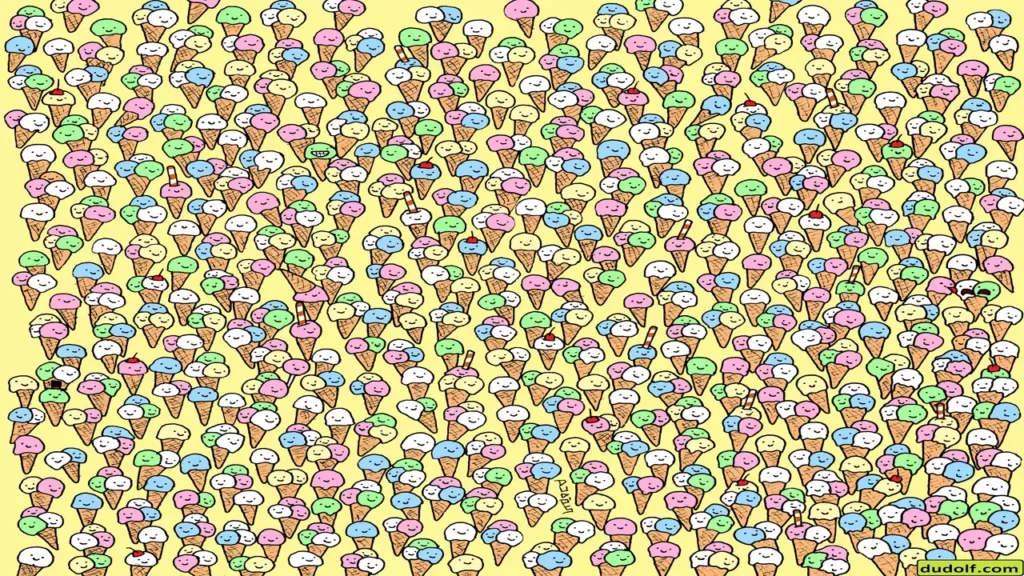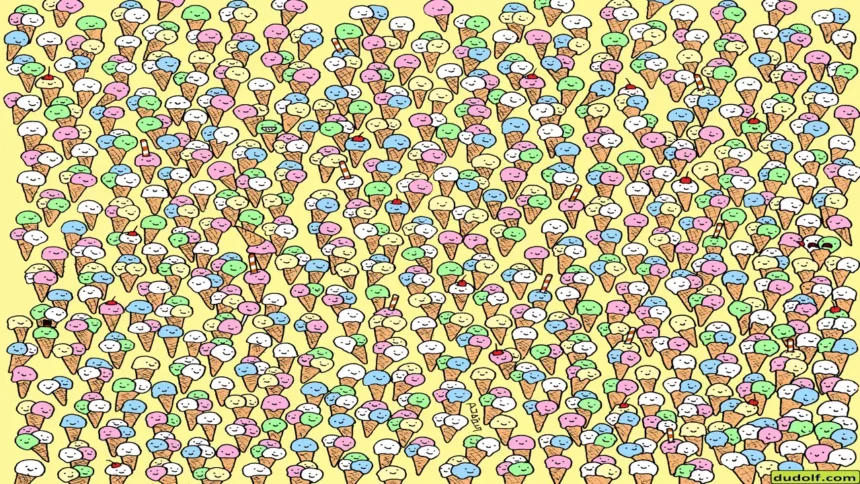In the realm of visual illusions, where perception dances with reality, lies a captivating puzzle that challenges the human eye and mind alike.
Imagine a scene filled with an array of colorful candies, each vying for attention, yet nestled among them, hidden in plain sight, is a solitary lollipop waiting to be discovered.
This seemingly simple task, to spot the lollipop among the candies in a mere 8 seconds, is not just a test of visual acuity but a journey into the fascinating world of optical illusions.
Introduction to Optical Illusions:

Optical illusions have intrigued and confounded humanity for centuries, captivating both scientists and artists alike.
These visual phenomena play tricks on our perception, revealing the intricacies of how our brains interpret the world around us.
From the classic ambiguous figures like the famous Rubin’s Vase to more modern creations like the spinning dancer, optical illusions come in various forms, each challenging our cognitive processes in unique ways.
The Lollipop Puzzle:
Among the plethora of optical illusions that have captured the imagination of people worldwide, the ‘Spot the Lollipop’ puzzle stands out for its simplicity and widespread popularity.
The premise is straightforward: within a crowded scene of assorted candies, your task is to locate the lone lollipop hidden amidst them, all within the brief span of 8 seconds. Sounds easy, right? Well, think again.
The Challenge:
As participants engage with the ‘Spot the Lollipop’ puzzle, they quickly realize that the task is not as straightforward as it appears.
The candy-filled landscape presents a dazzling array of colors, shapes, and textures, creating a visual cacophony that challenges even the keenest observers.
The lollipop, deliberately camouflaged among its sugary companions, demands a sharp eye and swift decision-making to be successfully spotted within the time limit.
Understanding Visual Perception:
To comprehend why the ‘Spot the Lollipop’ puzzle is so captivating, one must delve into the mechanisms of visual perception.
Our brains process visual information at remarkable speeds, piecing together fragmented data to construct a coherent representation of the world around us.
However, this process is not infallible; it is susceptible to biases, heuristics, and the influence of surrounding stimuli.
The Role of Attention:
Central to our ability to solve visual puzzles like ‘Spot the Lollipop’ is the concept of attention.
Attention acts as a spotlight, directing our cognitive resources towards specific elements within our field of view while filtering out irrelevant information.
In the context of the puzzle, honing in on the lollipop amidst a sea of candies requires focused attention and the ability to differentiate subtle cues that distinguish it from its surroundings.
Gestalt Principles:
The Gestalt principles of visual perception offer valuable insights into why some elements stand out while others recede into the background.
Principles such as proximity, similarity, and closure influence how we group visual stimuli, shaping our perception of the overall scene.
In the ‘Spot the Lollipop’ puzzle, these principles come into play as participants attempt to discern patterns amidst the candy chaos, searching for clues that might lead them to their sweet prize.
The Power of Expectation:
Expectation plays a significant role in how we perceive visual stimuli.
Our brains are predisposed to seek out familiar patterns and shapes, often filling in gaps or making assumptions based on past experiences.
In the context of the lollipop puzzle, participants may rely on preconceived notions of what a lollipop looks like, guiding their search as they scan the scene for recognizable features.
Cognitive Biases and Illusions:
Despite our best efforts, cognitive biases can lead us astray, distorting our perception and hindering our ability to solve visual puzzles.
Illusions such as the famous Kanizsa Triangle demonstrate how our brains can be tricked into perceiving nonexistent shapes or patterns based on contextual cues.
In the case of the lollipop puzzle, biases towards certain colors or shapes may inadvertently steer participants away from the true target.
Training the Eye:
Like any skill, spotting the lollipop amidst the candies requires practice and refinement.
As participants engage with the puzzle repeatedly, they develop strategies and techniques to improve their performance.
Over time, they learn to focus their attention more efficiently, identify subtle visual cues, and filter out distractions that might impede their progress.
Through perseverance and dedication, they hone their ability to conquer the challenge within the allotted time frame.
The Science of Speed:
The 8-second time limit adds an extra layer of complexity to the ‘Spot the Lollipop’ puzzle, transforming it from a leisurely pastime into a race against the clock.
Time pressure alters the dynamics of visual processing, compelling participants to make rapid decisions and prioritize information based on its perceived relevance.
This heightened sense of urgency not only tests participants’ visual acuity but also their ability to perform under stress.
The Neuroscience of Perception:
Neuroscientists have long been fascinated by the mechanisms underlying visual perception, studying how the brain processes and interprets visual information.
Through techniques such as functional magnetic resonance imaging (fMRI) and electroencephalography (EEG), researchers gain insights into the neural circuits involved in tasks like ‘Spot the Lollipop,’ unraveling the complex interplay between sensory input, attentional mechanisms, and higher-order cognitive processes.
Applications Beyond Entertainment:
While the ‘Spot the Lollipop’ puzzle offers hours of entertainment for puzzle enthusiasts of all ages, its implications extend far beyond mere amusement.
Studies have shown that engaging with visual puzzles and games can enhance cognitive function, improve attentional control, and even mitigate age-related cognitive decline.
By challenging the brain to process complex visual information quickly and accurately, puzzles like this one serve as valuable tools for cognitive training and rehabilitation.
Conclusion:
The ‘Spot the Lollipop’ puzzle represents a captivating intersection of art, science, and human perception.
As participants immerse themselves in the colorful world of candies and lollipops, they embark on a journey of discovery, unraveling the mysteries of visual perception one sweet clue at a time.
Through attention, pattern recognition, and a dash of intuition, they strive to conquer the challenge and claim victory over the elusive lollipop hidden in plain sight.
So, next time you encounter a seemingly simple visual puzzle, remember that beneath its surface lies a rich tapestry of cognitive processes waiting to be explored and understood.

